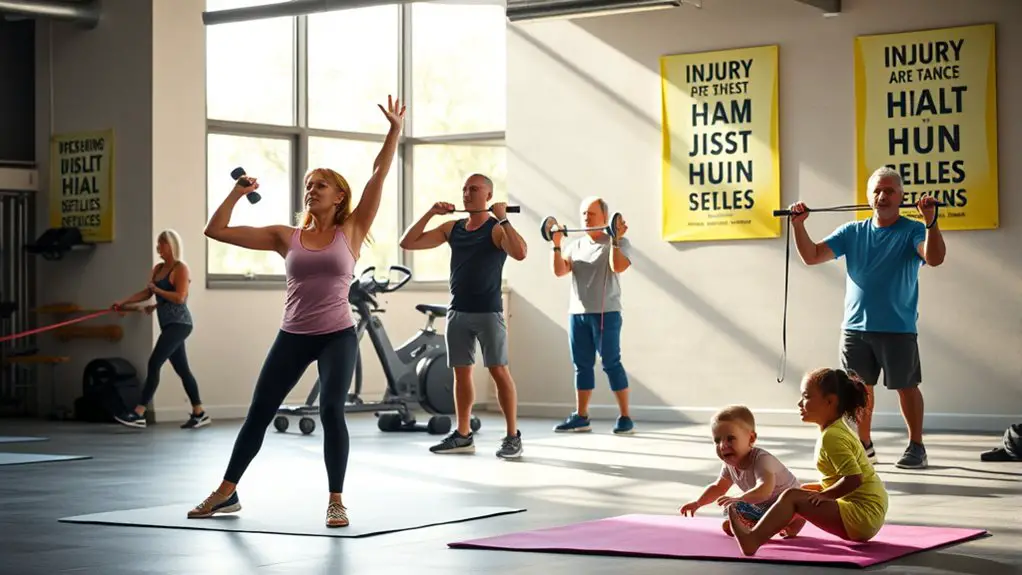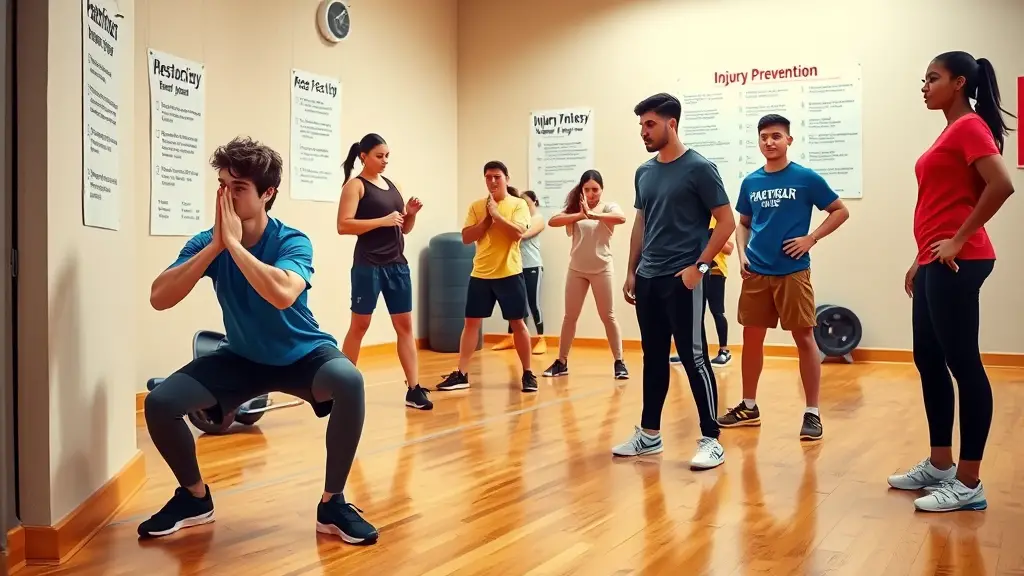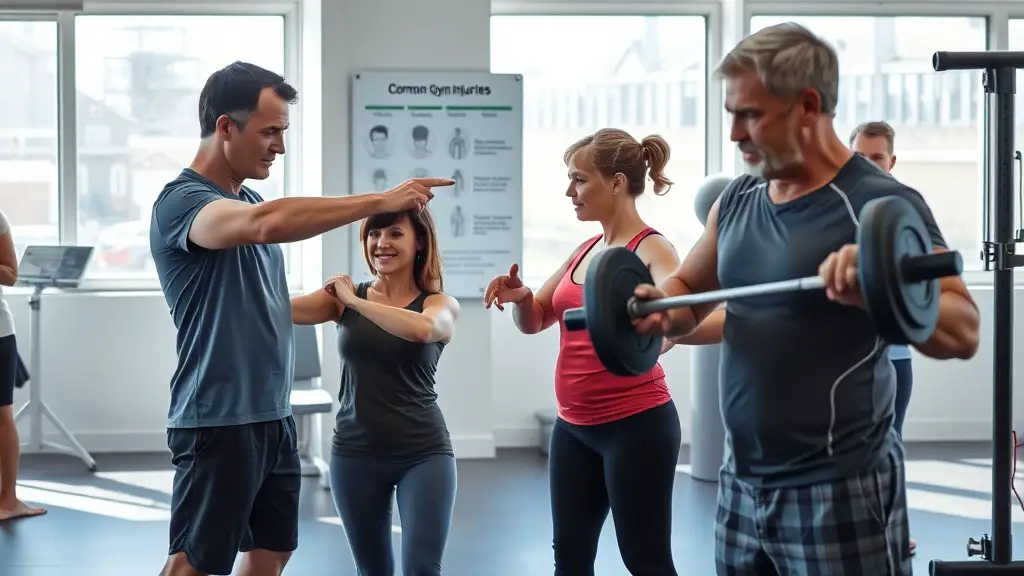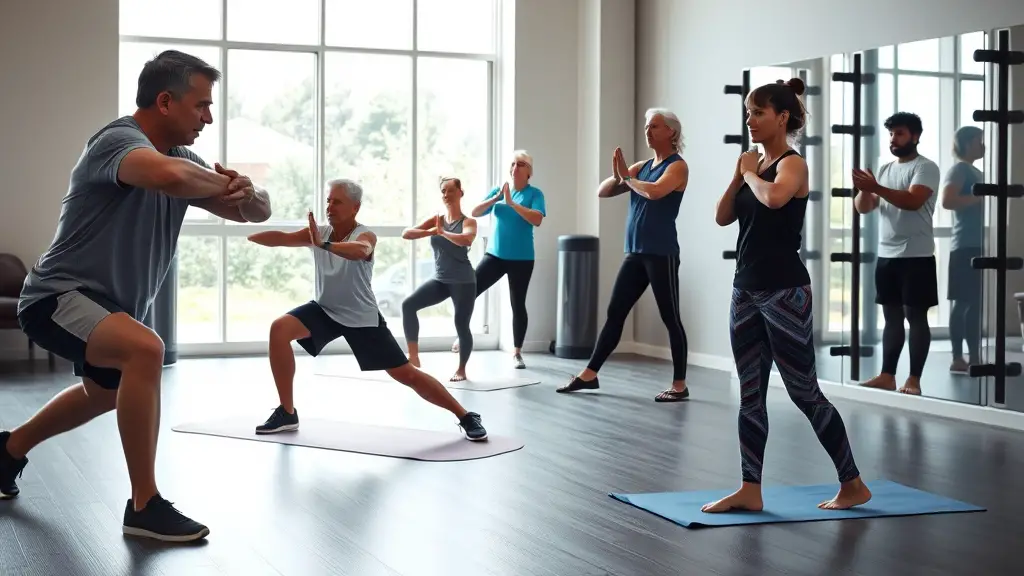How to Avoid Common Gym Injuries in Different Age Groups

To avoid common gym injuries, you need to recognize the unique risks associated with your age group. Teenagers should focus on proper supervision and avoid peer pressure, while young adults must prioritize warm-ups and varied routines. Middle-aged individuals should strengthen their core and listen to their bodies, and seniors must emphasize balance and flexibility. Always adjust intensity levels based on how you feel and consider consulting a professional for tailored guidance. There’s more to explore on injury prevention strategies.
Understanding the Unique Risks for Teenagers

When it comes to gym injuries, teenagers face unique risks that can stem from both physical and psychological factors. The influence of peer pressure often leads you to adopt training regimens that aren’t appropriate for your current fitness level. This can result in improper form or overtraining, increasing the likelihood of injuries. Additionally, social media plays a significant role in shaping your perceptions of fitness norms. You might feel compelled to emulate the workouts of influencers, which can push you beyond your limits or introduce you to techniques that aren’t suitable for your body. Furthermore, the lack of experience in recognizing your own physical limits can exacerbate these issues. Inadequate supervision in gyms often means that you may not receive proper guidance, making it essential to be aware of these risks. Understanding these factors can help you make safer choices and reduce the likelihood of injury during your workouts. Moreover, being informed about monkeypox transmission methods is crucial, as gyms can be a potential environment for spreading infections if proper hygiene is not maintained.
Injury Prevention Strategies for Young Adults
To prevent injuries as a young adult, it’s essential to implement proper warm-up techniques before every workout. Engaging in dynamic stretches and mobility exercises prepares your muscles and joints for the demands of exercise. Additionally, mastering strength training fundamentals guarantees you build a solid foundation while minimizing the risk of strain or injury.
Proper Warm-Up Techniques
A proper warm-up is essential for preventing injuries, especially for young adults who are often enthusiastic to dive straight into their workouts. To maximize your warm-up effectiveness, focus on these three techniques:
- Dynamic Stretching: Engage in movements that mimic your workout, like leg swings or arm circles. This increases blood flow and prepares your muscles for action.
- Mobility Drills: Perform exercises that enhance joint range of motion, such as lunges with twists or hip openers. This reduces stiffness and improves performance.
- Static Stretching: While often done post-workout, incorporating it lightly can help improve flexibility. Hold stretches for 15-30 seconds, targeting major muscle groups.
Strength Training Fundamentals
Understanding strength training fundamentals is essential for young adults aiming to build muscle safely and effectively. To maximize strength training benefits, start with proper form and technique. Focus on compound movements like squats and deadlifts, as they engage multiple muscle groups. Gradually increase weights to avoid strain and guarantee your body adapts.
Incorporate varied strength training techniques, such as free weights and resistance bands, to enhance stability and prevent overuse injuries. Always prioritize a balanced routine, targeting all major muscle groups at least twice a week. Don’t skip the cool-down; stretching post-workout aids recovery and flexibility. Finally, listen to your body—if you feel pain, adjust your approach. Following these strategies can help you train smart and stay injury-free.
Middle-Aged Fitness: Common Injuries and Solutions

Often, middle-aged individuals encounter specific injuries while pursuing fitness goals, largely due to changes in muscle elasticity, joint stability, and overall recovery capacity. Common injury types include tendonitis, lower back pain, and joint strains. To minimize these risks and enhance recovery, consider the following recovery tips:
- Warm-Up and Cool Down: Always include dynamic stretches before workouts and static stretches afterward to improve flexibility and reduce injury risk.
- Strengthen Core Muscles: A strong core stabilizes your body, reducing the likelihood of lower back pain and other injuries.
- Listen to Your Body: Pay attention to any discomfort during workouts and adjust intensity or frequency accordingly to prevent overuse injuries. Regular exercise is beneficial for youth, helping to reduce stress and improve overall well-being.
Senior Fitness: Safe Practices to Minimize Risk
As you age, engaging in regular physical activity becomes increasingly important for maintaining health and mobility, yet it also presents unique challenges that can lead to injuries. To minimize risk, focus on incorporating balance exercises into your routine. These exercises help improve stability and prevent falls, a significant concern for seniors. Simple activities like standing on one leg or using a balance board can be effective.
Additionally, prioritize joint flexibility through stretching and low-impact activities such as swimming or yoga. These practices enhance your range of motion and reduce stiffness, making everyday movements easier and safer. Always listen to your body and avoid pushing through pain.
Consider consulting a fitness professional who specializes in senior fitness to tailor a program that meets your needs. By following these safe practices, you can enjoy the benefits of exercise while minimizing the risk of injury.
The Importance of Warm-Up and Cool-Down Routines

When you engage in any physical activity, neglecting a proper warm-up and cool-down routine can increase the risk of injury. Incorporating these routines is essential for maintaining your overall fitness and preventing issues. Here are three key benefits:
- Dynamic Stretching: This prepares your muscles and joints for the workout ahead by improving flexibility and range of motion, reducing the likelihood of strains or sprains.
- Enhanced Performance: A proper warm-up elevates your heart rate and increases blood flow, enabling you to perform at your best.
- Cooldown Benefits: Cooling down after exercise helps your body shift back to a resting state, reducing muscle soreness and promoting recovery. Additionally, high-impact activities should generally be avoided during pregnancy to prevent injuries while exercising.
Listening to Your Body: Recognizing Signs of Overexertion
Recognizing signs of overexertion is essential for preventing injuries during workouts. You should monitor physical symptoms such as excessive fatigue, persistent soreness, and decreased performance. Additionally, incorporating rest days and adjusting your intensity levels can help maintain your overall fitness and well-being.
Physical Symptoms to Monitor
Monitoring physical symptoms is essential for preventing injuries during workouts, especially since your body may signal when it’s being pushed too hard. Pay attention to these key indicators:
- Monitoring Fatigue: If you feel unusually tired or lack energy, it’s a sign you may need to scale back your intensity.
- Identifying Pain: Sharp or persistent pain during exercise should never be ignored; it often signals potential injury.
- Changes in Heart Rate: An unusually elevated or erratic heart rate can indicate overexertion, requiring immediate attention.
Importance of Rest Days
Although many gym-goers may feel compelled to push through their routines daily, understanding the importance of rest days is essential for long-term success and injury prevention. Rest days offer significant benefits, allowing your muscles to recover and repair, which in turn enhances performance. Ignoring recovery can lead to overexertion, increasing the risk of injuries such as strains and sprains. You should listen to your body; signs of fatigue or persistent soreness indicate the need for a break. Incorporating rest days into your regimen not only supports muscle growth but also helps maintain mental focus and motivation. By prioritizing recovery importance, you’ll foster a sustainable fitness routine and reduce the likelihood of setbacks due to injury.
Adjusting Intensity Levels
After prioritizing rest days, it’s vital to adjust your workout intensity to match your body’s signals. Recognizing signs of overexertion is important for preventing injuries while applying the principle of progressive overload in your personalized workouts. Here are three key indicators to listen for:
- Persistent Fatigue: If you feel unusually tired beyond normal post-exercise fatigue, it might be time to lower the intensity.
- Increased Heart Rate: An elevated heart rate that doesn’t stabilize can signal overexertion; consider scaling back your efforts.
- Joint Pain: Discomfort or pain in your joints is a clear sign to reassess your workout intensity and modify accordingly.
Seeking Professional Guidance: When to Consult a Trainer or Therapist
How can you guarantee you’re getting the most out of your workouts while minimizing the risk of injury? Consulting a qualified trainer or therapist is essential. They can assess your fitness level, provide personalized workout plans, and teach proper techniques to prevent injuries.
Here’s a quick reference to help you identify when to seek professional guidance:
| Scenario | Action |
|---|---|
| New to exercise | Consult a trainer |
| Experiencing pain | Seek a therapist |
| Training for a specific event | Work with a specialized trainer |
| Recovering from an injury | Explore therapy options |
| Plateau in progress | Get a trainer’s insight |
Trainer qualifications, like certifications and experience, are vital in ensuring you receive effective guidance. Additionally, various therapy options can help rehabilitate injuries, improve flexibility, and enhance overall performance. Prioritize your safety and efficacy in the gym by seeking professional help when needed. It’s also important to listen to your body and adjust your activity level to prevent further injury.
Frequently Asked Questions
What Are the Best Exercises for Injury Prevention Across All Ages?
When it comes to injury prevention, why not focus on balance and flexibility? These elements are key for everyone, regardless of age. Incorporating balance training—like single-leg stands or stability ball exercises—can enhance your coordination. Meanwhile, flexibility exercises such as dynamic stretching or yoga improve your range of motion. Together, they create a strong foundation, reducing the likelihood of injuries and keeping you active and healthy in your fitness journey.
How Does Nutrition Impact Injury Recovery in Different Age Groups?
Nutrition plays an essential role in injury recovery, and adhering to age-specific diets can enhance healing. For you, it’s important to follow nutrition guidelines tailored to your age group. Younger individuals may need higher protein for muscle repair, while older adults benefit from increased calcium and vitamin D for bone health. Hydration also matters; staying well-hydrated supports overall recovery. By aligning your diet with these principles, you’ll optimize your recovery process effectively.
What Should I Do if I Feel Pain During a Workout?
What should you do if you feel pain during a workout? First, don’t ignore it; pain management is essential. You might need to stop and assess the situation. Consider workout modifications to reduce strain on the affected area. If the pain persists, it’s wise to consult a professional. Remember, pushing through pain can lead to more serious injuries, so listen to your body and adjust your routine accordingly for safer training.
Can I Still Exercise With a Previous Injury?
Yes, you can still exercise with a previous injury, but it’s essential to proceed cautiously. Incorporate rehabilitation exercises tailored to your condition, ensuring they’re approved by a healthcare professional. While working out, listen to your body; if you experience pain, stop immediately. Modify your routine to accommodate your injury, prioritizing recovery. Consistently monitoring how your body reacts will help you maintain fitness without exacerbating your condition. Always consult with a professional before starting.
How Often Should I Change My Workout Routine to Avoid Injuries?
Your body’s like a finely tuned machine; if you don’t give it the right fuel and maintenance, it can break down. To avoid injuries, it’s essential to vary your workout routine every 4 to 6 weeks. This routine variation keeps your muscles challenged and prevents overuse. Additionally, maintaining a balanced workout frequency, incorporating strength, cardio, and flexibility training, will help you build resilience and adapt, ensuring you stay injury-free while achieving your fitness goals.





